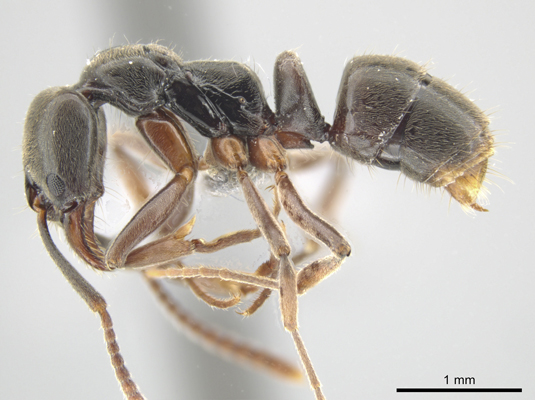
Asian needle ant. PHOTO: J. Longino / Image Copyright © AntWeb 2002 – 2023. Licensing: Creative Commons Attribution License
This species is native to China and adjacent East Asian areas, and was first identified and recorded in the U.S. in the 1930s. Formerly classified as Pachycondyla chinensis, it has more recently become a significant urban pest along the Mid-Atlantic coastal areas from Georgia to Virginia., and will no doubt spread within the southeastern U.S. in the coming years.
According to a bulletin on this species by the North Carolina State University (NCSU) Extension Office, “unlike pest ants such as the fire ant and the Argentine ant associated with areas that have been disturbed by human activity, the Asian needle ant is able to nest in both disturbed and ‘natural areas’ like forests. This ant has been found in various settings from school cafeterias to residential lawns to logs in State and National Parks.”
Workers are small, at about 0.10 to 0.125 inch long, and have a black body and lighter brown mouthparts and legs. The female reproductives, or swarmers, are larger, at nearly 0.25 inch long. The winged males are about the size of the workers.
Per the NCSU bulletin, one unusual feature of this species is its “inability to cling to smooth surfaces like glass. By carefully capturing an Asian needle ant in a glass jar, one can observe that, unlike other ants that will climb the sides of the jar, the Asian needle ant will make a few futile attempts to climb before confining itself to the base of the jar.”
Colony size for this species appears to be small, at only up to several hundred individuals, and there can be multiple reproducing queens. They prefer to nest in moist ad dark areas beneath stones, logs and similar landscape items or other debris around homes. Nests are usually shallow, at not more than several inches, down into the soil. Several colonies can living near each other, so the total population present (infestation) can be many thousands.
This species appears to feed mostly on other small insects and arthropods, and can inflict a painful sting capable of producing an anaphylactic shock reaction, if pressed against the body. Unlike fire ants, however, this species does not readily attack to defend itself or its nest. Another big reason for its pest status outside of structural pest control is its habit of forcing out native ant species and taking over territories can threaten local biodiversity. Per NSCU, Asian needle ants often “directly eat [native ant species populations], consume their food, or take over their nest sites. When the Asian needle ant eliminates the native species or reduces their abundance, many roles, like seed dispersal and predation of forest pests, are left unfilled.”
REFERENCES
- North Carolina State University Extension Office Bulletin, accessed 2/17/23: Entomology.ces.ncsu.edu/asian-needle-ant
- Truman’s Scientific Guide to Pest Management Operations, Seventh Edition, available for purchase at MyPMP.net/shop
Leave A Comment